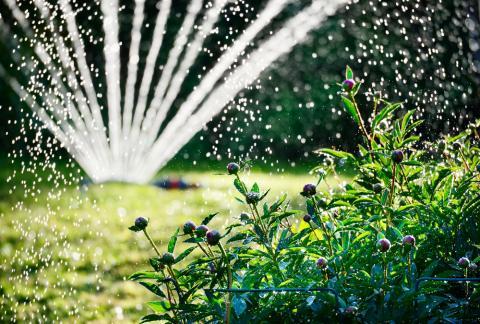
Overwatering isn't just bad for plants: It's also bad for the environment. We only have so much water on this earth, and it's imperative we do our best to conserve what we have. Here are five ways to save water in your garden.
Collect Rain Water & Use Old Water
Did you know the United States receives enough precipitation during an average year to cover the States to a depth of about 30 inches? That’s basically equivalent to approximately 1,430 cubic miles of water each year. Imagine if everyone collected rainfall? Imagine how much water that would conserve and save? Thankfully, it’s really simple to collect rainwater. All you have to do is divert the water from your drainpipe into a water barrel.
You can also reuse old water, often coined grey water, from baths, showers, and washing machines in your garden. It’s a great way to put it to good use. You can literally buy greywater diverters that divert the water from your bath to an irrigation system or a water barrel. Just make sure, if you do this, that you avoid using water contaminated with bleach, disinfectant, dishwasher salt, or other strong cleaners. These can harm plants, damage soil, or even pose a health risk. You’re better off switching to natural cleaning products that are safe for the environment. You can’t go wrong cleaning with vinegar, baking soda, and essential oils, that’s for sure. Also, using castile soap mixed with water to wash your hands is a great idea. The simpler the cleaning products the better. This way, you won’t have to worry about any pollutants getting into your water barrel.
Plant Flowers That Need Less Water
Generally speaking, all the plants in your garden should be water conscious, not just the flowers. That being said, there are several flowers you can plant that need less water than others, but still look just as beautiful. Some options include lavender, verbena, orange daylily, and yarrow. It’s good to go with plants that are generally drought-resistant and can go a few days without water. Make sure to look into the drought-resistant plants in your area and hardiness zone that you can plant. Also, don’t just do this with flowers—make sure to look into how drought-resistant any plant you want to incorporate into your garden is before getting it. The less water you have to use the better! Also, look into planting a rain garden.
Use The Right Amount Of Water
Not only is it about conserving water, it’s about using water properly when you must use it. It all depends on your soil type, but light, sandy soils need watering more frequently than heavy soils. Clay-based soils can be watered less frequently, but need more water when they are watered. Do some research into what kind of soil your area has. You might also want to look into the pH balance of your soil as well, just to know how healthy it is. Adding homemade compost to your garden beds will help improve your soil, if it’s low quality, thus make watering easier as well. Make sure to always check and see if the soil is dry before watering, too, as you never want to overwater your plants.
Look After Your Soil
The best way to save water in your garden is to definitely have high quality soil, as I mentioned earlier. Adding organic matter to your soil improves its structure, which helps it retain much more moisture. Also, you can prevent moisture from evaporating during dry spells by mulching flowerbeds, and around the base of trees and shrubs. You can even mulch the surface of hanging baskets to trap in moisture. There are so many ways to keep your soil high quality which leads to water conservation in the long run.
Water At The Right Time
You don’t need to overwater your garden—not only is it wasteful, but it’s more work for you! Instead, check if you need to water your plants or not by looking at the soil. If it’s damp, it’s good. If it’s dry, then you water it. The best way to tell is to check deeper into the soil, about a spade deep. If your soil is mainly clay based, it may feel damp whether it’s irrigated or not. Sandy soil also tends to feel drier too, even if it has water in it. If that’s the case, you should definitely pay attention to your plants and see if they show any signs of water stress. This occurs when leaves change by getting darker or moving position. When this occurs, note how the soil feels and looks. You’ll have a better idea of what your soil is like when it needs more water.








